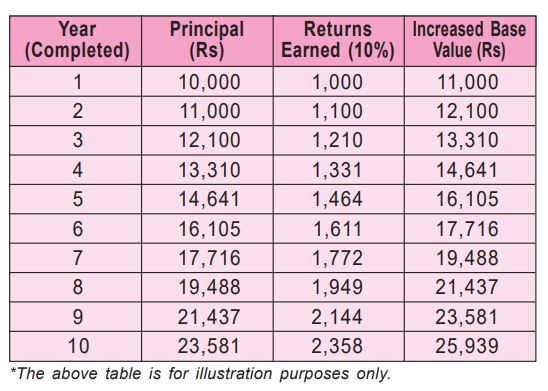As you start investing in mutual funds, understanding the concept of compounding is really important. But before we explore how compounding works when it comes to investing, let’s understand what “compounding” really means.
Say you place a tiny seed in the soil. With care and patience, that seed evolves into a tree that bears new seeds. These seeds when planted go on to sprout into more trees, each producing even more seeds. This cycle persists, and that’s precisely the essence of compounding.
Now, let’s explore how the power of compounding influences your investments.
What does compounding mean when it comes to investing?
Compounding is the process of earning returns on both your initial investment and the returns you’ve already earned. This means that as you invest your original amount and reinvest the returns you’ve gained, you may have the opportunity to witness your portfolio grow over time.
How is compounding calculated?
The following formula illustrates how you can compute compounding:
FV = PV * (1 + r) ^n
Where,
FV = Future value of the investment
PV = Present value or initial investment
r = Rate of return
n = Number of compounding periods
By employing this formula, you can determine the future value of your investment for various rates of return and timeframes.
No need to worry about doing the math manually – there’s a simpler option available. You can make use of an online compounding calculator. Nevertheless, it’s crucial to keep in mind that these tools do not take into account market unpredictability and the impact of inflation.

In general, this is how compounding works.
Say you invest Rs 10,000 in an avenue that offers fixed interest rate of 10% per annum. This is how your investment will grow:
*The above table is for illustration purposes only.
So, your initial investment was Rs 10,000 and your final corpus after 10 years would be Rs 25,939.
How does compounding work in mutual funds?
In traditional examples of compounding (like the one shared above), the rate of interest has been assumed as fixed and is known when the investment is made. This type of example of compounding perfectly fits and is applicable to guaranteed income products like fixed deposits, bonds, NSCs, term deposits etc.
Mutual funds, on the other hand, operate in the dynamic environment of the financial market. Their returns are not fixed and can fluctuate based on the performance of the underlying assets like stocks and securities. In mutual funds, the concept of compounding is more complex and involves the growth of the invested amount over time.
Why it is different in mutual funds?
Now, as the mutual fund invests in various assets like stocks and securities, the total value of these investments changes daily based on market fluctuations. Consequently, the Net Asset Value (NAV) of the mutual fund also changes daily. This means that the growth or decline in the value of the underlying investments directly influences the NAV of the mutual fund.
The crucial point to understand is that when we talk about returns in mutual funds, it’s more about “growth on growth” rather than “interest on interest.” The returns are not fixed; they depend on the market performance of the fund’s underlying assets. Over time, as the values of the underlying stocks and securities held by the mutual fund increase, the NAV of the mutual fund also grows. This continuous growth in the NAV, driven by the appreciation of the underlying assets, is what is commonly referred to as compounding in the context of mutual funds.
In summary, the compounding effect in mutual funds arises from the dynamic nature of the market, where the value of the investments and, consequently, the NAV of the mutual fund change over time, leading to a compounding effect on returns.
An example:
Here’s an example illustrating the compounding effect in a hypothetical Equity Fund investment over a 19-year period:

Initial Investment (01 Feb 2004):
Investment: Rs 18,00,000
NAV: 25.75
Fund Value: Rs 18,00,000
Five-Year Growth (01 Feb 2004 to 01 Feb 2009):
NAV Growth: 25.75 to 110.2
Fund Value Growth: Rs 18,00,000 to Rs 98,10,000
Compounded Annual Growth Rate (CAGR): 21.4%
Five-Year Growth (01 Feb 2009 to 01 Feb 2014):
NAV Growth: 110.2 to 145.6
Fund Value Growth: Rs 98,10,000 to Rs 1,20,00,000
Compounded Annual Growth Rate (CAGR): 6.4%
Nine-Year Growth (01 Feb 2014 to 01 Feb 2023):
NAV Growth: 145.6 to 480.3
Fund Value Growth: Rs 1,20,00,000 to Rs 5,00,00,000
Compounded Annual Growth Rate (CAGR): 16.8%
Overall Growth (01 Feb 2004 to 01 Feb 2023):
NAV Growth: 25.75 to 480.3
Fund Value Growth: Rs 18,00,000 to Rs 5,00,00,000
Compounded Annual Growth Rate (CAGR): 15.9%
How to maximise compounding benefits in mutual funds?
To maximise compounding benefits in mutual funds, follow these simple steps:
- Begin investing as soon as possible to give your money more time to grow. Even small, regular investments can significantly impact over the long term.
- Opt for mutual fund schemes with a consistent track record of good returns. Look for well-managed funds that align with your financial goals and risk tolerance.
- Whenever possible, increase your investment amount over time.
- Spread your funds across different types of mutual fund schemes to reduce risk.
Compounding is a powerful concept that can help you grow your money over time by earning returns on returns. Mutual funds are one of the best ways to benefit from compounding. You can maximise the compounding effect in mutual funds by reinvesting your dividends and capital gains and investing for the long term. You can also use a mutual fund calculator to estimate the compounded returns of your mutual fund investments and plan your investments accordingly.
However, you should remember that mutual funds are vulnerable to market risks. They do not guarantee any fixed or assured returns. If you are seeking to capture the compounding benefits of mutual funds but are unsure where to begin, you can log into FundsGenie or check our mutual fund recommendation on page 13.







